The Food & Wine Guide to Kitchen Knives
How to select and treat your knives like a chef.
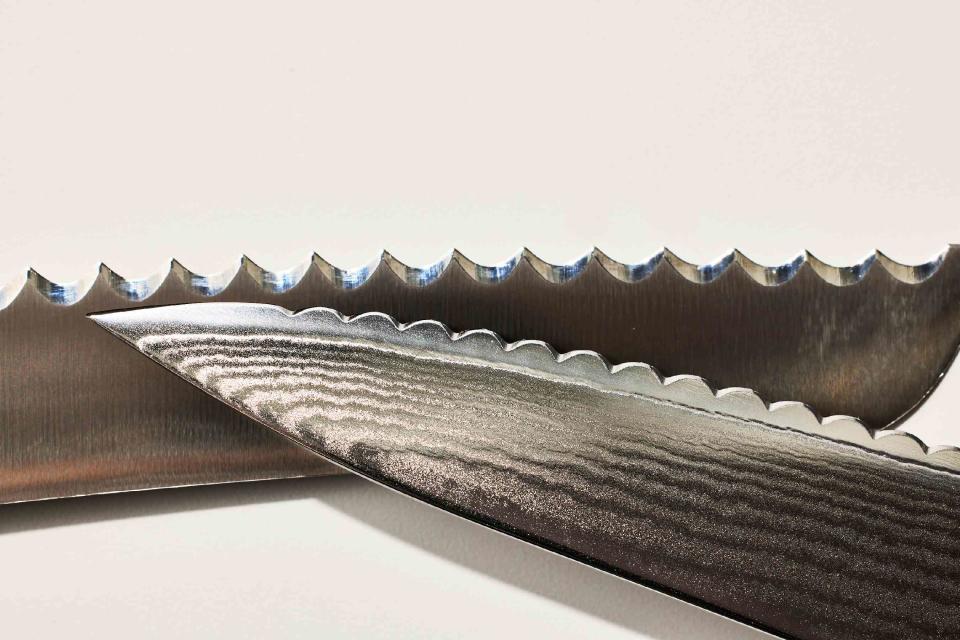
Victor Protasio / Prop Styling by Claire Spollen
Serious home cooks know there are a few tools that should never be overlooked when investing in your kitchen. A durable Dutch oven, a trusty nonstick skillet, and a workhorse stand mixer all come to mind, but none are more important than your kitchen knives. Before you turn on the stove or start up the blender, almost all meal prep starts with a slice of a (hopefully high-quality) blade. Knowing which knives you need to own is just as important as knowing how to use them — this is true for everyone from first-time cooks to professional chefs.
To help you shop for kitchen knives with confidence, we’ve created this guide to knives, starting with a breakdown of the most important aspects of a knife to consider, and recommending which knives to buy. All of our knowledge is informed by years of culinary experience, input from chefs, and rigorous product testing for F&W Faves in our lab as well as real-world tests conducted at home. Read on to learn all about our favorite kitchen knives, and the best practices for using, storing, and maintaining knives for years to come.
The Anatomy of a Kitchen Knife
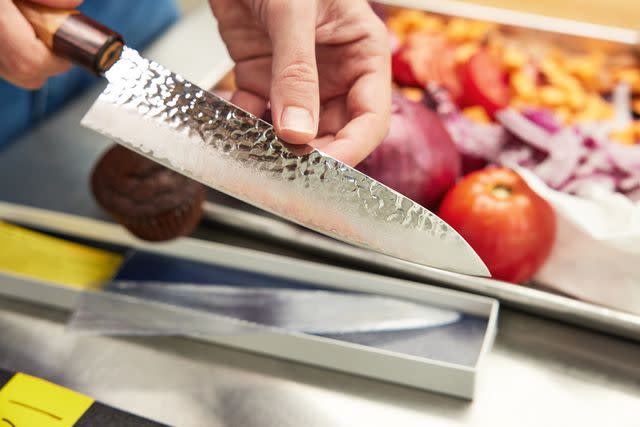
Russell Kilgore / Food & Wine
Understanding the elements of a knife is the first step to becoming a more discerning knife owner — you’ll know more about what to look for when choosing a knife. These are the key elements of any kitchen knife:
The Handle
The handle is the section where your hand will grip the knife while in use. This will include the tang (the internal steel continued from the blade), rivets (studs from the tang that secure the handle material), and the butt (the back end of the knife handle). A “full-tang” knife means the blade material runs all the way through the handle to the butt, which should be the case for any quality kitchen knife. The bolster is the area between the handle and the blade, which provides balance and protects your hand from slipping toward the sharp edge.
The Blade
The blade is sharpened metal of the knife used for cutting and slicing. This includes the tip (the end point of the blade furthest from the handle), the spine (the unsharpened top edge of the blade), the edge (the sharpened side of the blade), and the heel (the back end of the blade, closest to the handle).
Forged vs. Stamped Knives
Kitchen knives are made in two different ways: forging and stamping. There are low-quality versions of both styles, but a fully-forged knife will be more durable for most kitchen tasks. There are great versions of both knife varieties, so the choice depends on your intended use. Many knife brands make both forged and stamped knives.
Forged Knives: Forging involves heating and hammering a single piece of steel and molding it into shape with either a manual or machine process. Forged knives are heavier, typically full-tang, and often stronger because of the intensive molding process. Brands like Shun, Dalstrong, Wüsthof, Mercer, and Miyabi all offer forged blades.
Stamped Knives: Stamping is a process where the knife shape is “stamped” out of a single piece of metal and then heated and molded into the desired shape before sharpening. Typically stamped knives are lightweight and less expensive (depending on the brand). Victorinox, Winco, Henckels, Wüsthof, and Zwilling all offer stamped knives.
Typical Knife Blade Materials
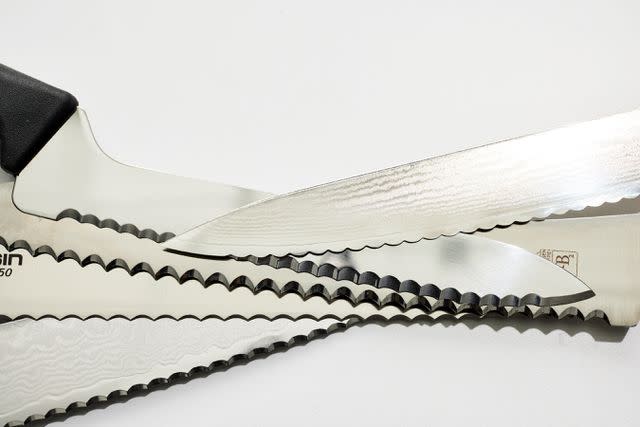
Victor Protasio / Prop Styling by Claire Spollen
These days several materials can be used to create a kitchen knife. The blades generally fall into a few categories, each with its strengths. Your budget, what feels comfortable to you, the way you like to use knives, and your aesthetics will all factor into the type of blade you might choose.
Stainless Steel
Stainless steel is the most common knife blade material. It’s typically an alloy, usually iron combined with chromium, nickel, or molybdenum. It’s rust-resistant and non-reactive, but won’t get quite as sharp as carbon steel. Stainless steel knives also tend to be more affordable than knives made from other materials.
Carbon Steel
Carbon steel, an alloy of carbon and iron, is another common knife material. Carbon steel knives are durable and very sharp and are easier to sharpen than stainless steel, but will be more susceptible to corrosion and rust, so must be cleaned and stored with care.
High Carbon Stainless Steel
High carbon steel is the upgrade to both stainless and carbon steel and manages the best of both worlds: strength, sharpness, and corrosion resistance. Professional chefs will generally lean on high carbon stainless steel knives.
Damascus Steel
Damascus steel blades are made using a specific intricate folding and layering process that gives superior strength and sharpness thanks to the blades. During forging, two types of steel are intensively layered together to create a powerful blade with a beautiful, swirly pattern that’s recognizable (and coveted) everywhere.
Ceramic
Ceramic knives are lightweight, sharp, non-reactive, and have the best edge retention, but ceramic’s brittle nature can be challenging for certain tasks in the kitchen. For a low-maintenance but inexpensive knife, ceramic is a good option.
Types of Kitchen Knives
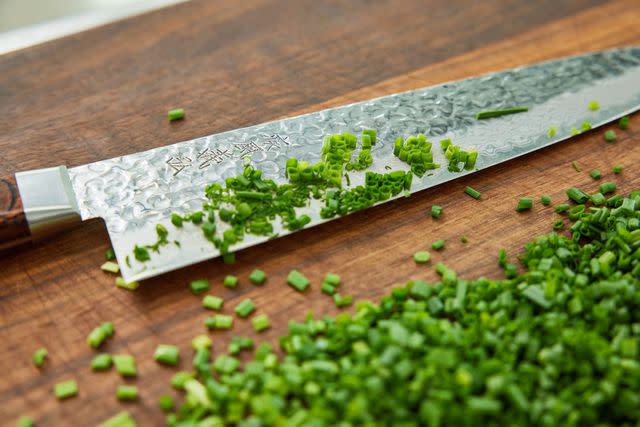
Russell Kilgore / Food & Wine
There are dozens of types of kitchen knives. Most tasks can be accomplished with the most essential kitchen knives: a chef’s knife, a serrated knife, and a paring knife. If you’re looking to expand your repertoire, these are most of the styles an accomplished home chef might acquire.
Chef’s Knife: The all-purpose, most-used knife in any kitchen. Chef knives are generally 8 to 12 inches long, with a wide, tapered blade that can slice, chop, and dice ingredients with a rocking motion.
Serrated Knife: Any scalloped-edge knife, usually used to slice items with a hard exterior and tender interior (a loaf of bread, for example – hence, many serrated knives are sold as bread knives). The blade is generally 7 to 10 inches in length, and can be offset in some cases.
Paring Knife: A short, precision-focused knife usually used to peel or core ingredients. Paring knives are generally 3 to 4 inches from heel to tip.
Santoku: A Japanese-style all-purpose knife, slightly shorter than the typical chef’s knife and with dimples on the blade to reduce sticking while slicing.
Utility knife: The go-to for tasks between the chef’s knife and paring knife, with a rigid but manageable-sized blade.
Fillet Knife: A flexible fillet blade is helpful for efficiently fileting more delicate pieces of meat, poultry, and fish.
Boning Knife: A rigid knife helpful for getting bones out of roasted meats and poultry.
Carving Knife: A long, narrow blade meant for cutting beef or poultry, carving knives offer some extra flexibility to maneuver around bones and have extra reach.
Cleaver: Generally made from carbon steel, the flat blade of a cleaver can vary in size but is usually meant for breaking through tough ingredients or butchering tasks.
Nakiri: A specialized Japanese knife made for cutting vegetables, slightly smaller than a cleaver with a similar shape.
Once you have your knives on hand, spend some time learning how to use them, practicing knife techniques for properly slicing and dicing typical ingredients.
Related:Slice Like a Chef: A Guide to Culinary Knife Cuts
Kitchen Knife Care & Storage
If you’re investing in quality knives, you should know how to care for them. Rule No. 1? Never put your knives in the dishwasher. Instead, hand-wash them with warm water and soap and dry them thoroughly. Rule No. 2: Store your knives properly, using a knife block or a magnetic strip. These strips can be mounted to the wall, and they’re a fun way to display your collection while keeping the blades safe. Pro tip: Peel the knife off the magnet carefully to avoid damaging the point or the honed edge. “You never want the last thing leaving the surface to be the edge,” says Ryan Perrier, general manager of Strata knife shop in Portland, Maine.
One good way to protect knife blades, particularly if you keep them in a drawer, is with an in-drawer organizer like the Wüsthof In-Drawer Knife Organizer. Vincent Lau, knife sharpener at Korin knife shop in New York City, protects his knives with these Japanese magnolia wood sayas, or sheaths. You’ll need to match the sheath to the knife; they’re not one size fits all. Knife rolls, with their pockets to store individual knives, also prevent blades from knocking into one another (which can dull them). They’re also a helpful accessory when transporting knives, whether to an Airbnb for a weekend getaway or from your home to a friend’s house to help make a special dinner.
Sharpening Your Kitchen Knives
While all of these products will help prevent blades from getting damaged and dulling, inevitably, you’ll have to sharpen your knives. If you plan to sharpen your knives at home, read the results of our tests of our favorite knife sharpening tools, or (if you don’t want to sharpen your knives yourself) bring your blades to your local knife shop. They’ll likely have trained professionals who can do the job for you. If local sharpening isn’t an option, try a mail-based sharpening service like Sharpenters or Knife Aid.
Cutting Boards
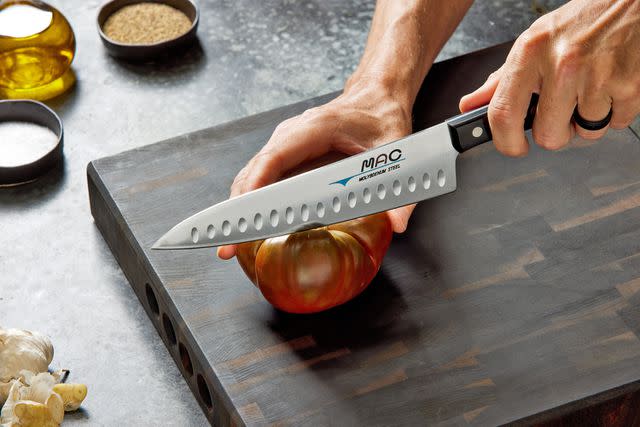
Russell Kilgore / Food & Wine
The right cutting board can make all the difference in caring for your knives as well. Depending on your typical cooking behaviors, you'll have different necessities. These are a few of the categories you might need in a cutting board:
Where to Buy Kitchen Knives
You travel to eat—why not travel to shop for kitchen tools, too? While all of the knives we recommend can be purchased online, you can visit the knife stores below in person if you get a chance. Each focuses on high-quality craftsmanship and can provide a lasting, practical souvenir, plus plenty of cutlery advice. Just remember to check your bag on the flight home.
Korin (New York City)
This New York City institution, founded by Saori Kawano in 1982, has become a go-to for chefs everywhere. Counting several Nobu chefs among its customers, Korin offers high-end Japanese knives and wares at all price points.
Northside Cutlery (Chicago, IL)
Drawing upon their roots in hospitality and customer service, Kevin Silverman (formerly a chef) and Danielle Burgos opened up this shop in 2021. They offer sharpening services and specialize in locally made knives and accessories.
Bernal Cutlery (San Francisco, CA)
Josh Donald and Kelly Kozak founded Bernal almost two decades ago as a local sharpening service. It quickly grew into a one-stop cutlery shop that sells Japanese and Western knives along with refurbished vintage and antique blades.
Strata (Portland, ME)
Founded by former butcher Evan Atwell, Strata focuses on knives made by small-scale producers working at the highest level from places as varied as Germany and New England. Plus, the shop offers classes on knife fundamentals.
Coutelier (New Orleans, LA and Nashville, TN)
Jacqueline Blanchard opened her shop in 2015, following a career as a chef (at spots including The French Laundry). In addition to selling Japanese knives, Coutelier educates customers about Japan’s knifemaking traditions.

